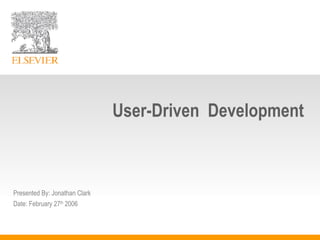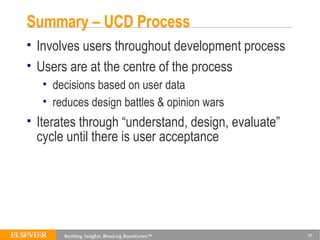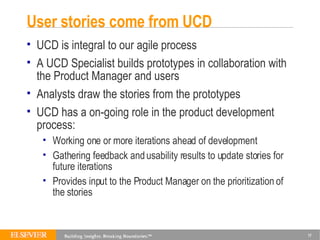User Driven Development for NFAIS
- 1. User-Driven Development Presented By: Jonathan Clark Date: February 27 th 2006
- 2. Product Development should start and end with the user (UCD) user understanding user acceptance avoid opinion wars should deliver┬Ājust what's needed (Agile) understanding of user needs by all involved prioritising to these needs avoid requirements wars Create opportunities for common ground between IT and Business
- 3. User-Centred Design Process Understand the user, their tasks and their goals Evaluate the UI, not the user Design for the user, make sure they can efficiently and easily complete their tasks
- 4. Example: Electronic Information Retrieval Librarian Morning Lunch Afternoon After Hours Researcher Student Practitioner Significant generalizations; Use of Elsevier electronic products is much smaller
- 5. Example: Differences and Similarities Values completeness and exhaustiveness Clinical decision support and fact lookup Interested in seeing what has NOT been done Need for a concise and easily scannable answer Links to references and evidence Current awareness Quick and Advanced searching Help user understand content Spellchecking Needs to publish original research Has little time to sift through large answer sets Researchers Practitioners Need for concise overviews Time pressured Highly mobile Collaborative Needs to secure grants/funding Likes to cast a broad search first, then systematically refine results
- 6. User-Centred Design Process Understand the user, their tasks and their goals Evaluate the UI, not the user Design for the user, make sure they can efficiently and easily complete their tasks
- 7. Evolution of the Refine Results box
- 8. Evolution of the Refine Results box
- 9. Evolution of the Refine Results box
- 10. Evolution of the Refine Results box
- 11. How to display citation tools? ?
- 12. Summary ŌĆō UCD Process Involves users throughout development process Users are at the centre of the process decisions based on user data reduces design battles & opinion wars Iterates through ŌĆ£understand, design, evaluateŌĆØ cycle until there is user acceptance
- 13. Product Development should start and end with the user (UCD) user understanding user acceptance avoid opinion wars should deliver┬Ājust what's needed (Agile) understanding of user needs by all involved prioritising to these needs avoid requirements wars
- 14. Elsevier Agile Development Process Based on Agile software development and project management methodologies rapidly emerging in the last few years: Scrum, eXtreme Programming, Crystal etc. Key characteristics: Iterative Time-boxed Dedicated team Collaborative Customer focused Testing intensive
- 15. Elsevier Agile Development Process
- 16. Tell the storyŌĆ” Requirements are captured as ŌĆ£StoriesŌĆØ on index cards. Stories are short descriptions (1-2 sentences) of something a user wants to do or a capability the system must have. Typical form: ŌĆ£As a ___, I want to __, so that I can ___ŌĆØ. Acceptance criteria go on the card (usually the back) Stickers show progress: Red: Development has started Orange: Development has completed Yellow: Testing by Developers & QA is complete Blue: The Product Manager has signed off that card is complete
- 17. User stories come from UCD UCD is integral to our agile process A UCD Specialist builds prototypes in collaboration with the Product Manager and users Analysts draw the stories from the prototypes UCD has a on-going role in the product development process: Working one or more iterations ahead of development Gathering feedback and usability results to update stories for future iterations Provides input to the Product Manager on the prioritization of the stories
- 18. PathCONSULT Online diagnostic clinical decision support covering general pathology. Designed to be used at the point of work. Image based. Core is differential diagnosis tool to compare conditions. At launch will includes 500 most useful conditions based on feedback from Pathologists
- 19. Differential Diagnosis: low-fi prototype Amyloidosis Clear cell tumors H├╝rthle cell (oncocytic) tumors Hyalinizing trabecular adenoma and related lesions LYMPHOID TUMORS AND TUMORLIKE CONDITIONS Malakoplakia Medullary carcinoma MESENCHYMAL TUMORS METASTATIC TUMORS Other neuroendocrine tumors Parathyroid tumors Poorly differentiated carcinoma Home > Differential Diagnoses Then, select up to 5 diagnoses to compare Add ’āĀ ’ā¤ Remove Follicular carcinoma Follicular adenoma Papillary carcinoma First, select a body system Thyroid Select a different body system View Differential
- 20. Differential Diagnosis: low-fi prototype Home > Differential Diagnoses > Comparison Image caption (stain, magnification) Image caption (stain, magnification) Image caption (stain, magnification) Diagnostic Pearl Diagnostic Pearl Diagnostic Pearl 25 additional images available View complete diagnostic information for Follicular carcinoma Diagnostic Pearl Diagnostic Pearl Diagnostic Pearl 15 additional images available View complete diagnostic information for Follicular adenoma Diagnostic Pearl Diagnostic Pearl Diagnostic Pearl 18 additional images available View complete diagnostic information for Follicular carcinoma Papillary carcinoma Remove from comparison Follicular adenoma Remove from comparison Follicular carcinoma Remove from comparison
- 21. Differential Diagnosis: as deployed
- 22. Differential Diagnosis: as deployed
- 23. Summary When the process revolves around the user user understanding increased => better products teams have a common focus => better collaboration When traditional requirements are replaced by stories / low-fi prototypes etc whole team better understands user needs => faster When short iterations are used better prioritisation => more focus on business value The challenge is how to manage interface with less agile parts of the organisation
- 24. ŌĆ£ Process is what you focus on when you donŌĆÖt have the right people with the right skillsŌĆØ Jared Spool
Editor's Notes
- #2: Elsevier is a publishing company! Historically we have tended to be product / brand driven; the danger is that this tends to lead to product development that doesnŌĆÖt meet user needs consistently. Historically too we have viewed IT rather as we have viewed printers ŌĆō as a commodity; this tends to create a distance between IT and business people and this in turn leads to product development becoming just an interesting engineering problem, again thereŌĆÖs a danger of losing touch with the user and user needs So what have we done to address this?
























![Thank you [email_address]](https://image.slidesharecdn.com/user-driven-development-for-siia-1197208408629516-3/85/User-Driven-Development-for-NFAIS-25-320.jpg)